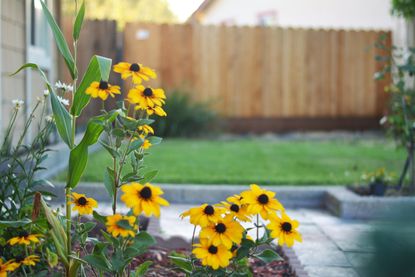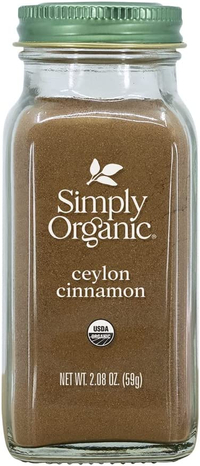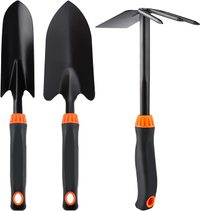Using cinnamon in a garden - these expert gardeners all use this common kitchen spice to keep their outdoor plants healthy
It's not only a versatile ingredient when used in the kitchen, but this cinnamon has a host of benefits for your garden, too


Looking after your backyard is more than just watering your plants and sowing the odd seed, you'll need to know about the appropriate plant care if you want your flowers and shrubs to thrive. We all know the benefits of shop-bought fertilizers and pest repellents, but what you probably didn't know is that there's a staple ingredient in your kitchen cupboard that promises both of these benefits and more.
Cinnamon isn't only a versatile spice when used for cooking, but it has multiple purposes within your garden, too. Besides being a natural rooting agent and helping to keep pests at bay, it also has natural anti-fungal properties which help to target white mold, a common problem that infects your outdoor plants this time of year.
To learn more about how this plant care hack can help keep your backyard looking its best, we caught up with some expert gardeners. From how to apply this spice to your soil to the plants you'll want to steer clear of, they share their best-kept tips on using cinnamon for a healthier garden blow.
How does cinnamon benefit the plants in your backyard?

Cinnamon is something of a wonder ingredient when it comes to potential benefits for your backyard. 'It has antifungal properties that can help prevent the growth of mold and mildew on your plants,' explains Diana Cox, expert gardener at The Gardening Talk. 'It can also help to stimulate root growth, provide essential nutrients to your plants, and it's also been found to increase the germination rate of seeds.' We take a closer look at each of these benefits below.
1. Preventing white mold
When spring is unusually cool and wet (conditions most of us have experienced this season) white mold is especially common in the garden. Presenting as a white fluffy-looking residue on your plants' leaves, stems, or the surrounding topsoil, it can make it difficult for your flowers and shrubs to photosynthesize and even lead to rot if left untreated.
That's where cinnamon comes in. This humble spice has antifungal properties that make it an excellent natural fungicide for combatting the signs of mold. 'When sprinkled on soil, it helps to prevent mold growth as well as other fungal diseases, such as powdery mildew and black spot, that can harm plants,' says Richa Kedia, gardener and blogger at Nursery Lady.
2. Boosting growth
Not only does cinnamon prevent fungal diseases, but it can actually promote better growth of your plants, too. This is thanks to containing special hormones that stimulate root growth, helping plants to develop stronger and healthier root systems.
Just like using coffee grounds as a fertilizer, the best part of using cinnamon to boost plant health is that it's completely safe and non-toxic. 'Unlike chemical pesticides, fungicides, and fertilizers, cinnamon won't harm beneficial insects or contaminate your soil and water supply,' Richa notes. 'Plus, it's affordable and readily available, making it an easy and cost-effective solution for any gardener.'

Organic ground cinnamon, Amazon
This pure Ceylon cinnamon from Amazon contains no GMOs, ETO, and is certified organic by QAI. Sustainably sourced without the use of toxic pesticides or irradiation, it's the best choice for your backyard (and has a delicate mild flavor for use in the kitchen, too!)
3. Repelling pests
There are certain species of wildlife, such as bees, that we want to encourage in our backyards. Others such as slugs, snails, and black flies can cause serious, irreparable damage to our beloved flora and fauna. If you're wondering how to get rid of fungus gnats or pesky mites or aphids, this wonder ingredient also has pest-repelling properties to keep them at bay.
'When I first started gardening, I had a problem with ants invading my plants,' Richa explains. 'I sprinkled cinnamon powder around the base of my plants and on the soil surface, and to my surprise, the ants disappeared. I also noticed that other pests, like gnats and flies, no longer bothered my plants either.'
This is all down to a clever compound called cinnamaldehyde which has insecticidal properties, making cinnamon the perfect non-toxic alternative to chemical pesticides. 'It disrupts the nervous system of insects, making it difficult for them to move and eventually leading to their death,' Richa adds.
How to apply cinnamon to your plants

Applying cinnamon to your plants isn't merely a case of sprinkling the spice over every inch of your flower beds and hoping for the best. There are various ways to apply it that are better suited to certain circumstances, and you'll want to know which one to use if you want the best results.
1. Sprinkle directly onto your soil
'One method is to sprinkle a small amount of cinnamon directly onto the soil around the base of your plants,' says Diana. This is probably the most simple way to apply the spice, but you'll need to make sure you avoid contaminating the base of particular plants that can be damaged by cinnamon (more on this later).
'Be sure to apply cinnamon to all parts of the plant, including the underside of the leaves,' Richa adds. 'You can apply cinnamon once a week for the best results.'
2. Dust directly onto leaves and stems

If you're targetting specific areas prone to mold such as leaves with a large surface area or fluffy-looking stems, you might want to add the cinnamon directly onto those specific places for the best results. To do this, use a teaspoon or tea strainer to gently dust the powder over those areas. You can also use this method to treat mold on houseplant soil.
3. Mix with water and spray onto plant stems
'Another option is to mix cinnamon with water to create a spray that can then be applied directly to the leaves and stems of your plants,' Diana explains. This can help distribute the cinnamon more evenly and will be the best method if you want to target pests.
'To make the spray, simply mix one teaspoon of cinnamon powder with four cups of water and stir well,' Diana adds. 'Be sure to shake the mixture well before spraying it onto your plants.'

3-piece hand gardening tool set, Amazon
If you're new to gardening, this 3 piece tool set from Amazon is all you need to get started. It includes a lightweight trowel, a hand transplanter, and double-hoe, all of which have an ergonomic grip handle and a hanging hole for convenient storage.
Are there any plants you should avoid using cinnamon on?

While cinnamon is generally safe to use on most plants, there are a few types of plants that may be more sensitive to it and are therefore best to avoid. As Diana notes: 'Plants in the nightshade family, such as tomatoes and peppers, are particularly susceptible to cinnamon toxicity, so it's best to avoid using it on them'.
According to Richa, cinnamon can also be too strong for seedlings, inhibiting their growth. To avoid any risk of damaging young plants, wait until they're more mature before using cinnamon on them. 'Orchids are also very sensitive to cinnamon,' she says. 'Plus other plants, such as ferns and prayer plants, have very sensitive leaves that can be damaged by cinnamon.'
If your want your flowers and shrubs to flourish, it's important to be mindful of which plants you use it on. Always research and test a small area before applying cinnamon to the entire plant and monitor its effects before any further use.
Be The First To Know
The Livingetc newsletter is your shortcut to the now and the next in home design. Subscribe today to receive a stunning free 200-page book of the best homes from around the world.

Lilith Hudson is the News Editor at Livingetc, and an expert at decoding trends and reporting on them as they happen. Writing news, features, and explainers for our digital platform, she's the go-to person for all the latest micro-trends, interior hacks, and color inspiration you need in your home. Lilith discovered a love for lifestyle journalism during her BA in English and Philosophy at the University of Nottingham where she spent more time writing for her student magazine than she did studying. After graduating, she decided to take things a step further and now holds an MA in Magazine Journalism from City, University of London, with previous experience at the Saturday Times Magazine, Evening Standard, DJ Mag, and The Simple Things Magazine. At weekends you'll find her renovating a tiny one-up, one-down annex next to her Dad's holiday cottage in the Derbyshire dales where she applies all the latest design ideas she's picked up through the week.
-
 How to Thaw a Frozen Pipe — Learn Everything You Need to Know in 5 Minutes With This Guide
How to Thaw a Frozen Pipe — Learn Everything You Need to Know in 5 Minutes With This GuideWinter storm caught you off guard? We asked an expert — just how do you thaw a frozen pipe?
By Hugh Metcalf Published
-
 The 12 Very Best Silk Bedding Pieces — As Our Style Editor Says: 'It's What Dreams Are Made Of!'
The 12 Very Best Silk Bedding Pieces — As Our Style Editor Says: 'It's What Dreams Are Made Of!'Slumber in lustrous luxury with the very best silk bedding sheets, duvets, pillowcases, and more — your sleep score will thank us later
By Julia Demer Published

